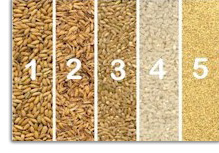

Rice is one of the world's most important food crops and more than
half of the people in the world eat rice as the main part of their
diets. Young rice plants have a bright green color and as the grain
ripens the plants turn golden-yellow. A typical rice kernel is 1/4
to 3/8 inches long. The following is a brief explanation of the rice
milling process:
 Photograph
(1) is a picture of rice still in its hull, this is
called paddy rice. The first stage of the milling process is to
remove the tough outer hulls (2) and the result is
brown rice (3), or rice with the bran coats still
intact. The next stage is to remove the bran coats, then rice is
polished, graded and packaged for use (4). The
resulting bran (5) is typically a by-product of the
milling process and because of it's very short shelf almost all of
the 40 million metric tons of rice bran produced each year is
discarded as unfit for human consumption.
Photograph
(1) is a picture of rice still in its hull, this is
called paddy rice. The first stage of the milling process is to
remove the tough outer hulls (2) and the result is
brown rice (3), or rice with the bran coats still
intact. The next stage is to remove the bran coats, then rice is
polished, graded and packaged for use (4). The
resulting bran (5) is typically a by-product of the
milling process and because of it's very short shelf almost all of
the 40 million metric tons of rice bran produced each year is
discarded as unfit for human consumption.
Rice bran is an incredible source of the vitamins, minerals, amino
acids, essential fatty acids and antioxidant nutrients that help
fight disease and promote good health. It's no wonder the healthy
oil that comes from our GMO Free rice bran is becoming so successful
at replacing GM and hydrogenated oils containing trans fat. Research
is on-going with this invaluable food source and scientists have
found components that may be extremely beneficial to human health.